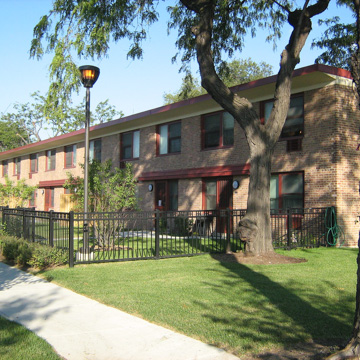Opened in 1947, Wentworth Gardens was erected in Armour Square, a neighborhood on the south side of Chicago. With the country’s entry into World War II, the Chicago Housing Authority (CHA) in tandem with the Federal Housing Authority (FHA) prioritized development for Black war industry workers. As a major industrial hub, Chicago was a destination in which many Black migrants sought labor opportunities. Due to residential segregation occurring throughout the country at this time, many of these migrants resided in the historically Black area of the South Side known as the Black Belt. Most of the housing within the Black Belt offered poor living conditions. Thus, for the CHA, these defense housing projects represented an opportunity to address the need for war industry worker housing while also providing improved housing for Black Chicagoans.
The project’s design adhered to the CHA preference in the 1930s and 1940s for low-rise developments. Wentworth consisted of 422 dwelling units with a density of 26 acres per unit. Erected in a gridiron layout, 28 two-story houses faced away from the street toward interior lawns. This layout was prevalent among public housing designs as architects sought to enhance community life. Since the development had no individual front yards, all outdoor space was meant to be shared collectively. Wentworth also included 9 three-story, U-shaped, walk-up apartment buildings. Both the apartments and row houses featured red brick exteriors, punched windows, and flat roofs. Vertical panels with glass windows placed above the front doors of the apartment buildings maximized the amount of light in the interior stairways.
Although the CHA initially selected a vacant tract of land near white neighborhoods, white aldermen and locals who feared the prospect of integration halted these efforts. In response, the CHA chose vacant sites in outlying regions of the city. Of the six site options, four were near Black middle-class enclaves and thus the CHA deemed these sites more suitable. In 1944, the CHA settled on a sixteen-acre industrial site on the periphery of the Black Belt. While the development prioritized Black war workers, white tenants were not ruled out. However, the preference for Black tenants deterred many white residents from moving into Wentworth.
Following the 1949 Housing Act, the CHA was expected to use tenants’ rent to cover the annual expenses of maintaining the public housing facilities. However, the majority of tenants were low income and, as a result, many of the CHA’s housing projects were left ill-maintained for decades. Coupled with the deindustrialization of the city, the unemployment rates for Black men skyrocketed, and much of Chicago’s public housing saw an increase in Black women-led families. Given the lack of resources, single mothers rallied together to form supportive social organizations. In 1971, the CHA formed Local Advisory Councils (LAC), following a mandate implemented by the U.S. Department of Housing and Urban Development (HUD) that required increased resident participation. Wentworth’s LAC aimed to forge and encourage communal life within the development. LAC workers organized children’s summer food programs and crime prevention initiatives. The LAC partnered with non-profit organizations and government agencies to provide social services, job training, and employment services to tenants.
Although the LAC provided support for Wentworth, maintenance problems and the lack of public funding were a constant issue. Consequently, Wentworth residents applied to the HUD residential management program, which granted residents more control over their developments. The Residents’ Management Company (RMC) was underfunded from its establishment in 1995, however, and it relied on community fundraising efforts under the leadership of RMC president Hallie Amey. RMC efforts led to the renovation of the development’s laundromat, field house, and other amenities.
When plans for the construction of the Chicago White Sox’s new baseball stadium got underway in 1985, Wentworth residents opposed the intended location on the south side of 35th Street, since it would take up approximately one-third of the Armour Square neighborhood and lead to resident displacement. Wentworth activists formed the Save Our Homes Neighborhood Coalition (SOH; later the South Armour Square Neighborhood Coalition) to launch a campaign of mass protests and demonstrations and meet with local and state officials to propose other locations for the stadium. Despite the residents’ fervent efforts, the stadium was approved and opened in 1991, leading to the demolition of 178 housing units and twelve neighborhood businesses, which offered employment for around 300 people.
In 1999, HUD implemented HOPE VI hoping to ease the housing crisis. Originally, the program was aimed to rehabilitate public housing, but in practice it demolished and significantly reduced public housing units. By 2000, Chicago mayor Richard M. Daley launched his Plan for Transformation for Public Housing, in which all high-rise developments were to be demolished and replaced with smaller-scale, mixed-income developments. In 2004, thanks to Wentworth activists, the development avoided demolition and the units were slated for a complete renovation. Yet in order for the renovation to occur, 90 percent of the units had to be vacated, leading to a significant number of displaced families. The renovation was completed in 2007 and reduced the number of units from 422 to 344.
References
Bowly, Devereux. The Poorhouse: Subsidized Housing in Chicago. 2nd ed. Carbondale: Southern Illinois University Press, 2012.
Dawn, Turner Trice. “South Side Activist's Vision Becoming Reality.” Chicago Tribune, December 6, 2004.
Feldman, Roberta M., and Susan Stall. The Dignity of Resistance: Women Residents' Activism in Chicago Public Housing. New York: Cambridge University Press, 2004.
Goetz, Edward G. “The Transformation of Public Housing Policy, 1985–2011.” Journal of the American Planning Association 78, no. 4 (September 2012): 452–463.
Hunt, D. Bradford. Blueprint for Disaster: The Unraveling of Chicago Public Housing. Chicago: University of Chicago Press, 2009.
Moore, Natalie. “Why the Chicago Housing Authority Failed to Meet Its Mixed-Income Ambitions.” WBEZ, March 23, 2017. https://interactive.wbez.org/cha/.





